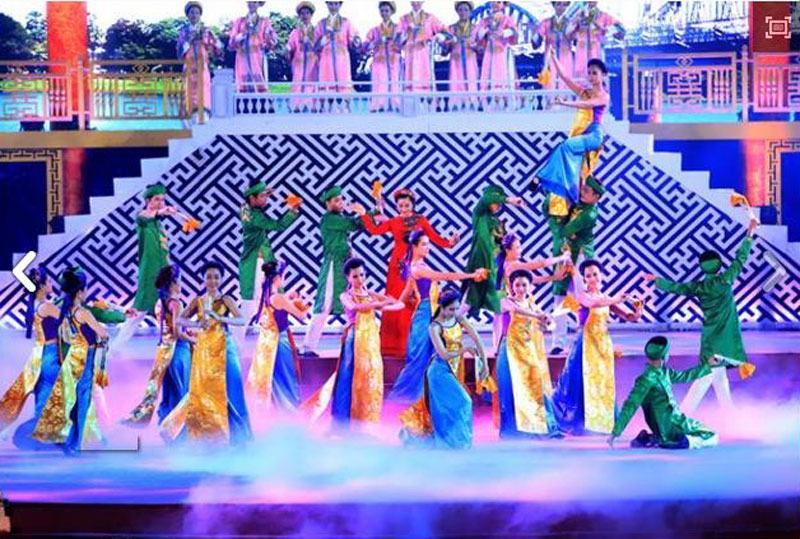
The Hue Festival 2018 came to an end on May 2, following a vibrant closing night featuring Hue’s royal court music performances and firework shows.
This year’s festival was held in the central province of Thua Thien-Hue from April 27 to May 2,
attracting thousands of visitors.

An performance at the closing night of Hue Festival 2018.
(Photo: VNA)
The 10th
edition of Hue Festival, an important event of the ancient imperial capital,
wrapped up after six days of exciting and impressive activities, said Nguyen
Dung, Vice Chairman of the provincial People’s Committee at the closing
ceremony.
The Hue
Festival 2018 offered stages for 786 performers representing 20 countries and
territories including Vietnam.
Audiences were provided chances to enjoy 72 stage shows as well as take part in
37 community activities held by local residents.
It aimed
to celebrate 712 years since the founding of Thuan Hoa - Phu Xuan, which is Hue today. The festival
was themed ‘Cultural Heritage with Integration and Development: Hue - One Destination,
Five World Heritages’.
The five
heritage statuses were awarded to the Complex of Hue Monuments, Hue royal court music, woodblocks, the imperial archives
of the Nguyen Dynasty and royal literature on Hue royal architecture.
"Van hien
kinh ky”, a highlight of the festival,was an art show which combined a
variety of elements: dance, chorus, animation, poem reciting and music. The
90-minute show featured all cultural values of Hue through heritage elements.
Meanwhile,
a show, titled "Am vong Song Huong” (Resonance of Perfume River), on April 29
involved hundreds of professional and amateur actors and actresses, depicting
the life cycle of people living on the rivers from their marriage, giving birth
and raising children to passing down their occupation from generation to
generation in a joint effort to preserve Hue cultural values.
The same
day, streets in the silent city of Hue
were bustling with performances by art troupes in a street parade. The art
troupes from countries and territories, including Japan,
the Republic of Korea,
Thailand, Mongolia, Belgium,
Poland and Slovakia,
brought their native colours to the streets. Audiences enjoyed their
performances, which demonstrated their circus skills, along with dance and
music, and displayed their costumes.
An "Ao
dai” show took place on May 1 evening, exhibiting exhibited collections of the
Vietnamese national long dress. The show, titled"The Heyday of Hue”, was
aimed at depicting"ao dai”in Hue
in different eras, with a focus on those worn during the imperial time under
the rule of the Nguyen Dynasty (1802-1945).
The
designers, hailing from different regions in the country, attempted to get
closer to Hue
by using symbolic patterns of the city on their designs, besides mimicking the
attires of royals and nobles.
Hue city
was the imperial capital of Vietnam
for hundreds of years. It is home to five UNESCO-recognised heritages, namely
the Hue ancient citadel relic complex – a World Cultural Heritage site; Nha
Nhac (Hue royal court music) - an intangible cultural heritage item; Nguyen
Dynasty’s wood blocks – a documentary heritage item; Nguyen Dynasty’s Chau ban
(royal administrative documents) – part of the Asia-Pacific Register of
UNESCO’s Memory of the World Programme; and literature on Hue royal
architecture - a documentary heritage.
Source: VNA
With an increasingly vibrant and widespread emulation movement aimed at building cultured residential areas and cultured families, Yen Thuy District has been making steady progress toward improving both the material and spiritual well-being of its people, while fostering a civilized, prosperous, beautiful, and progressive community.
Once lacking recreational spaces and community facilities, Residential Group 2 in Quynh Lam Ward (Hoa Binh City) has recently received attention for the construction of a new, spacious, and fully equipped cultural house. The project followed the model of state support combined with public contributions in both labor and funding.
The "All people unite to build cultural life" movement, which has been effectively integrated with Kim Boi district’s socio-economic development goals, is fostering a lively spirit of emulation across local residential areas, hamlets, villages, public agencies, and enterprises. In addition, through the initiative, traditional cultural values are being preserved and promoted, while community solidarity and mutual support in poverty reduction and economic development are being strengthened.
A working delegation of the Hoa Binh provincial People’s Committee led by its Permanent Vice Chairman Nguyen Van Toan on June 11 inspected the progress of a project to build the Mo Muong Cultural Heritage Conservation Space linked to tourism services in Hop Phong commune, Cao Phong district.
Born and growing in the heroic land of Muong Dong, Dinh Thi Kieu Dung, a resident in Bo town of Kim Boi district, in her childhood was nurtured by the sweet lullabies of her grandmother and mother. These melodies deeply imprinted on her soul, becoming an inseparable part of her love for her ethnic group's culture. For over 20 years, this love for her hometown has driven Dung to research, collect, and pass down the cultural values of the Muong people to future generations.
In the final days of May, the Ethnic Art Troupe of Hoa Binh Province organized performances to serve the people in remote, mountainous, and particularly disadvantaged areas within the province. These were not just ordinary artistic shows, but they were the meaningful journeys aimed at spreading cultural values, enhancing the spiritual life of the people and contributing to the preservation of ethnic minority cultural identities.



